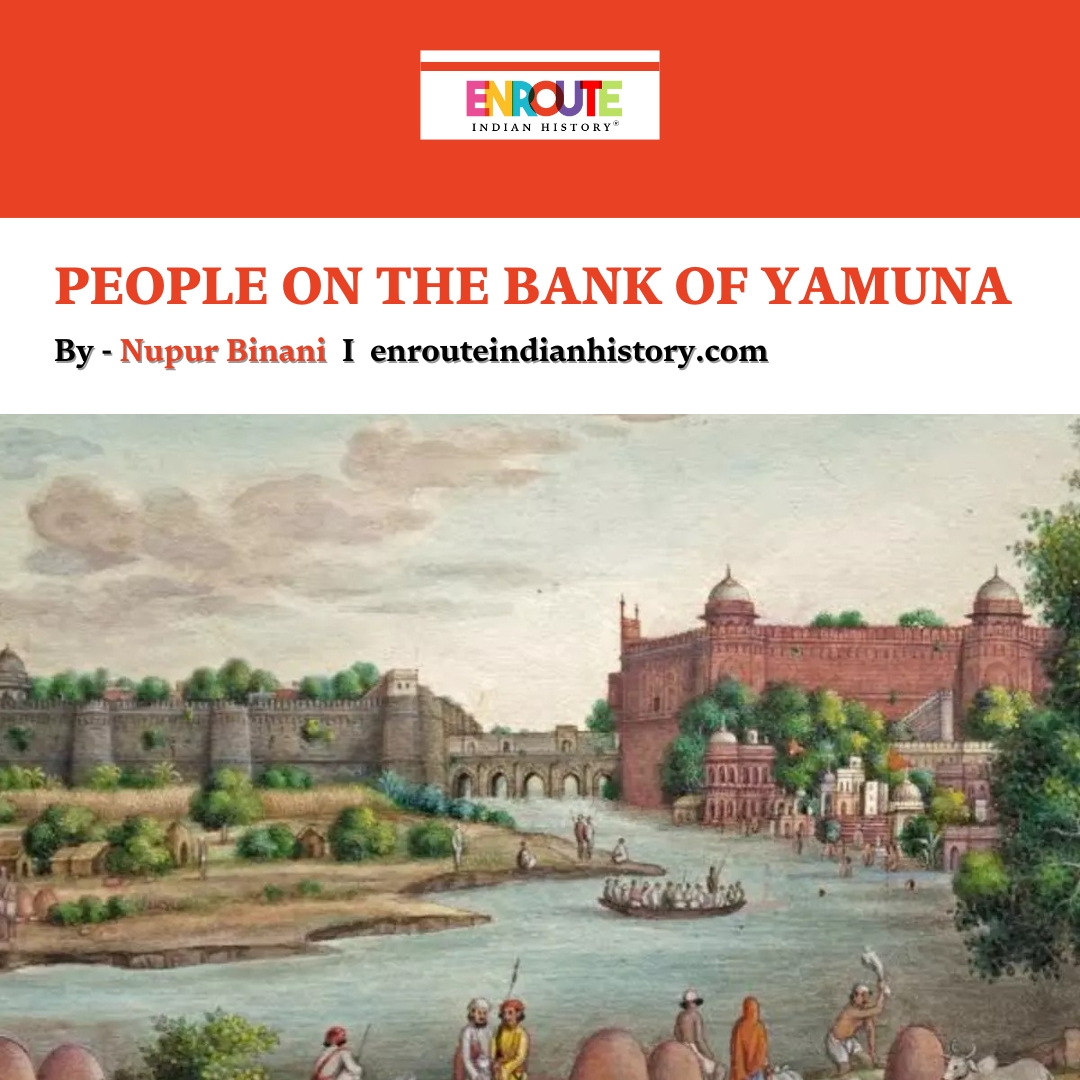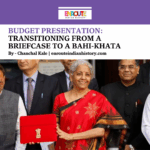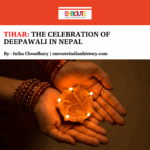
Travelling through Delhi metro, you encounter Yamuna bank station; while exiting from Kashmere gate, drivers of shared auto call out “Yamuna ghat, Ganesh ghat” but to which river are they highlighting? Delhi being a metropolitan is often regarded as a “developed city” but measuring this development we can’t forget the roots on which Delhi was established. Rivers play an important role in providing the desirable climate, land and demographic conditions for an ancient city to develop. The river Yamuna is the soul of the capital city but increasing modernity may force it to leave the body.

Mingled with the sewage and muck, it flows on as it always did since the beginning of time. They do not know the city’s relationship with the hilly ridge and the river Yamuna. For most the river can only be imagined as a pollutant, denoting it is ‘dirty’, or through the token plastic bags which local politicians retrieve from it annually, for a photo-op. The river flows on, however, irrespective of the usurping of its banks, regardless of its faded memory, still inextricably linked to the city and its environs. Nourishing, nurturing, and taking care of the ungrateful city, like a mother. A misty boat ride on a winter’s morning led one through flocks of poachers and other ducks, startled as one chanced upon them. From a bird’s-eye view, even two decades ago, Delhi was a big wetland. Today Yamuna is termed as a mere nala behind the backdrop of a beautiful city due to increasing pollution. The Yamuna is today dead from Wazirabad up to Etawah. There is hardly any flow during the dry season and the river looks more like a drain than a river in the non-monsoon months. On the other hand, swollen with silt and precious topsoil, carried away from the upstream, it overflows its banks during the monsoon inundating a large part of the area. Floods in the Yamuna are a common phenomenon even in Delhi, people living on its bank often experience the life of a river. The river upstream of Wazirabad water
work is comparatively less polluted. One can identify the difference in the colour of the water. Just below the waterworks one drain carrying sewage from Ghaziabad joins the river. About one km downstream of the river the Najafgarh drain joins the river from the right side and this drain carries waste water. At the Keshopur sewage treatment plant some waste water from the surrounding drain is treated but after only primary treatment about 30 percent of the water is again released into the drain. waste water from different industrial areas, including Wazirabad industrial areas flows into the ‘nullah’ and ultimately the entire polluted water finds its way to the Yamuna near
Timarpur. As Wazirabad water works holds all the water, only this drain water is available at Yamuna near Timarpur. The two famous ghats are famous; Kusia Ghat (with 12 ghats in a row) and the other, further downstream, Nigambodh Ghat (with 32 ghats i9 a row). Dirty water flows in front of these ghats, but people with blind faith in the purity of Yamuna
water still wash dead bodies in this dirty water before cremation. When in 1948 Gandhi’s samadhi was built the Yamuna may have been lowing by the side of the Rajghat. But now it has receded at least half km away from
Shantivan-Rajghat. Recently a boundary wall with barbed fencing at the top was erected right from Rajghat power house to Rail Road Bridge. This boundary wall has completely isolated the ghats from the Yamuna, artificial lakes have been constructed at Vijay Ghat and Shantivan as part of the beautification programme.

An incident from September 2010 highlights how people living on the bank are affected by unexpected rise of river water. The 100-year-old reticulated bridge, a sturdy yet graceful monument to colonial engineering, suddenly appeared vulnerable as strong currents swept water dangerously close, causing trains and road traffic across the bridge to be cancelled. Close to the bridge were the submerged homes of poor squatters; a few thousand residents had been evacuated and housed in tents where they stayed for the next two weeks until the river ebbed. For many of them, temporary displacement was an annual event and inescapable to the experience of living by the river.
Delhi was located in a hollow between the fifteen-million-year Ridge Forest and the river. When the rains came, the rainwater gushed down many rivulets on the ridge into large lakes. It collected in cusps, like the recently levelled Najafgarh Jheel. Canals were dug to coax the water back into the ever-flowing river. Along the way the water seeped into the soil and recharged the groundwater. Birds flew in and roosted. Animals drank even while being hunted as royal game. Today, vegetables grow on its bank. Rag-pickers and priests, along with fishermen, labourers, sand-dredgers and slum folks live here, servicing the city in one way or another. The river was unknown to most of the city but it still is central to the life of the city and to its ecology. The river is hard to see. Several bridges now span the river, more modern and faster than the ageing but classic old Yamuna pull. As one drives from the Ring Road to one of the several bridges and across them, the river does not appear to be viewed. It is somewhere there, but unseen.

Crossed everyday by thousands of commuters, it is not part of one’s imagination.
Even after these conditions, people still continue to practise their lifestyle dependent on river yamuna, Sarla yadav a resident of ghat 24 shares her experience. Yamuna Ghat 24 is a treasure trove of stories on the river Yamuna. She runs a boat business with her son Shyam who provides a nuanced personal account of living by the river and of eking out a meagre livelihood by plying boats. They are among a few families who have not sold their boats so far. In the 1960s, when Sarla Yadav moved to her marital home in Delhi as a teenager, she was thrilled to have the Yamuna flowing beside her small hut, crystal clear water that attracted tourists and worshippers on a daily basis. Reclining on her boat as she waits for passengers, the 60-year-old fondly recalls the days of her youth when she got enough travellers to ferry across ‘Yamuna ji’, generating an income good enough for her to dream of a bright, fulfilling future.“The water is so dirty now. People do not like coming here anymore. Now, I make just enough to be able to make ends meet,” she said. Yadav, along with her neighbours at Yamuna Bazaar, added that there was a time when they would use the water from the river, for washing, drinking and cooking.
Shanti, a resident of Yamuna bazaar states about another experience stating, even 10-15 years ago, we would have an annual swimming race on the Yamuna, for which we would prepare our children throughout the year. All these activities have stopped. A lot has changed in the Yamuna.
Though people have opted different activities but ghats in Delhi still have people serving tourists a boat ride, they have made it their source of income.
The new opening of aarti ghat is a great initiative to make people realise living in the metropolitan city they are still at the bank of yamuna, being submerged by growing development but the heart and soul of the capital city lies in flowing Yamuna water.

References -:
- Ravi Agarwal.A River Lost from View
- Amita Baviskar.What the Eye Does Not See: The Yamuna in the Imagination of Delhi
- Chandan Datta.Yamuna River Turned Sewer
- Adrija Roychowdhury.Life by the Yamuna before its degradation
- Awadhendra Sharan.A river and the riverfront: Delhi’s Yamuna as an in-between space
- Amita Bhaduri.Understanding the Yamuna and life around it
- Cultural significance of Yamuna in Delhi
- Delhi civilization around Yamuna River
- modern Delhi lifestyle
- Modernity and Yamuna River in Delhi
- Pollution in Yamuna River Delhi
- Yamuna River and Delhi's urban development
- Yamuna River impact on Delhi civilization
- Yamuna River pollution effects on lifestyle
- Yamuna River’s role in Delhi’s modernity



















